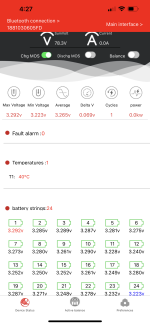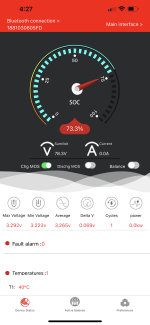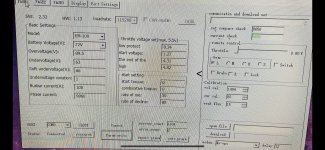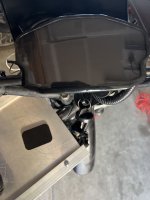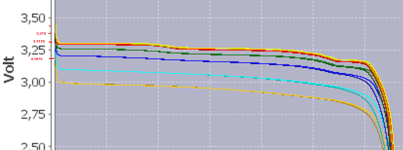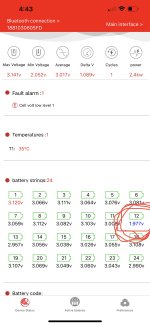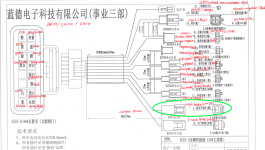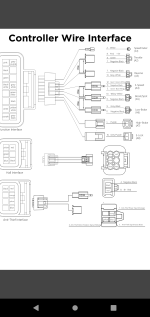Is power actually shutting off to the system, or is the controller simply ceasing to respond to control inputs?
The former indicates the BMS is shutting off it's output; the latter indicates the controller is hitting some form of LVC (there are often multiple levels of this in programmable controllers, and in smart BMSs).
If you don't want the controller to do any shutoff, you should set it's LVC below anything the pack would ever drop to.
If you do this, you should set the BMS LVC to be well above what it normally would be, so you aren't as hard on the cells, since the normal BMS LVC is intended to protect them from damage as a very last resort. The controller LVC is intended to provide everyday "empty battery" protection, so it's usually set a fair bit higher.
Also, the controller may have a better LVC protection layer that lets it just rollback power usage as it approaches LVC, so you can better use what capacity the battery still has as it gets closer to empty.
If you leave this up to the BMS, then it's just going to shut off output when it reaches LVC, since it's hardware can't do anything else.
You also need to set the controller's current limit to *below* what the battery is designed and able to handle, because it is the part of the system that is designed and built to limit current to prevent damage to the battery, etc., and it will do it in a graceful way that just rolls back motor power when it reaches this limit to hold it there, but let the system still run.
If you leave that up to the BMS, then the BMS will just cut power to the system when it's current limit is exceeded, since it's hardware can't do anything else.
For example, with a controller current limit of 200A, but a battery only capable of 150A peak and 120A continuous, the BMS doesn't have any choice but to shutdown whenever the controller pulls that 200A, which can happen in very short peaks that don't show up on your display/etc.
What usually causes the problem you describe is the battery being unable to handle the load, and sagging significantly in voltage. How the system responds to that depends on the BMS and controller design and settings.
If the sag is enough to trigger the BMS LVC, power will shut off, often requiring a power cycle to recover (sometimes requiring a charge cycle to be started or even completed before it will reset).
If the sag is only enough to trigger the controller LVC, it will just stop responding to control inputs until the voltage recovers enough to be above LVC--but as soon as the load is reapplied to cause it to sag that much again, it will stop responding again.
If the controller has a rollback-power feature as it approaches LVC, then the sag will just cause it to provide less power in response to the same control inputs, so it doesn't make the sag any worse.
The former indicates the BMS is shutting off it's output; the latter indicates the controller is hitting some form of LVC (there are often multiple levels of this in programmable controllers, and in smart BMSs).
If you don't want the controller to do any shutoff, you should set it's LVC below anything the pack would ever drop to.
If you do this, you should set the BMS LVC to be well above what it normally would be, so you aren't as hard on the cells, since the normal BMS LVC is intended to protect them from damage as a very last resort. The controller LVC is intended to provide everyday "empty battery" protection, so it's usually set a fair bit higher.
Also, the controller may have a better LVC protection layer that lets it just rollback power usage as it approaches LVC, so you can better use what capacity the battery still has as it gets closer to empty.
If you leave this up to the BMS, then it's just going to shut off output when it reaches LVC, since it's hardware can't do anything else.
You also need to set the controller's current limit to *below* what the battery is designed and able to handle, because it is the part of the system that is designed and built to limit current to prevent damage to the battery, etc., and it will do it in a graceful way that just rolls back motor power when it reaches this limit to hold it there, but let the system still run.
If you leave that up to the BMS, then the BMS will just cut power to the system when it's current limit is exceeded, since it's hardware can't do anything else.
For example, with a controller current limit of 200A, but a battery only capable of 150A peak and 120A continuous, the BMS doesn't have any choice but to shutdown whenever the controller pulls that 200A, which can happen in very short peaks that don't show up on your display/etc.
What usually causes the problem you describe is the battery being unable to handle the load, and sagging significantly in voltage. How the system responds to that depends on the BMS and controller design and settings.
If the sag is enough to trigger the BMS LVC, power will shut off, often requiring a power cycle to recover (sometimes requiring a charge cycle to be started or even completed before it will reset).
If the sag is only enough to trigger the controller LVC, it will just stop responding to control inputs until the voltage recovers enough to be above LVC--but as soon as the load is reapplied to cause it to sag that much again, it will stop responding again.
If the controller has a rollback-power feature as it approaches LVC, then the sag will just cause it to provide less power in response to the same control inputs, so it doesn't make the sag any worse.
Last edited:


